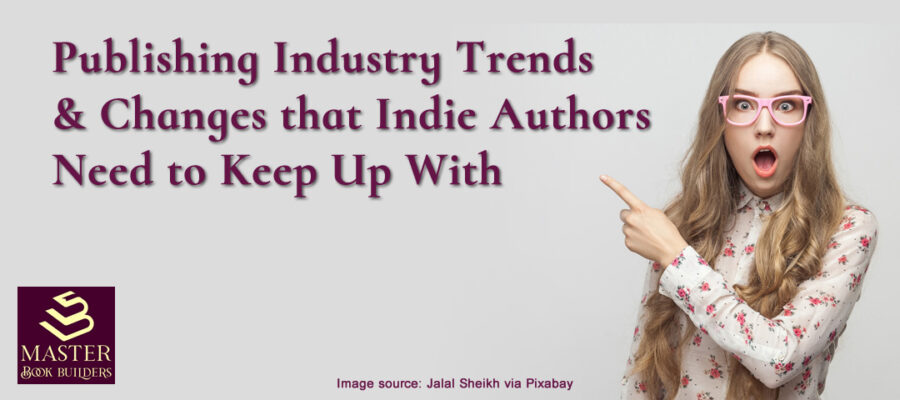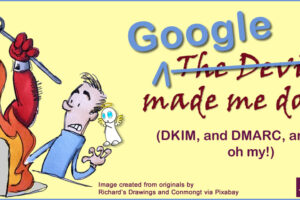[TfTi] Publishing Trends and Changes that Indie Authors Need to Keep Up With
I’ve been meaning to write this post since January, but I hope you’ll agree that other interesting topics kept showing up in my inbox to bump this one down the road. Well, I kept track of several links and when I saw a disturbing subject line about the death of Small Press Distribution last week, I decided to catch you up on five trends, both good and bad, that I think will most affect indie authors this year.
1. Lessons from SPD’s Demise
We can treat this as a stark example of the ongoing trend of consolidation and “bigness” in the traditional corporate publishing landscape.
From the last remaining page of the SPDBooks.org website:
“For more than five decades, SPD has distributed books for hundreds of independent literary publishers, allowing thousands of writers to bring diverse, experimental, and disruptive literature to audiences across the globe.”
Explaining that it had depended on grant funding to operate, SPD noted that its accomplishments in helping award-winning authors get their books to readers, “were no match for the challenges of a rapidly changing book industry and funding environment” as all its funding sources dried up.
The consequences to indie publishers and authors who used this variation on the traditional publishing model of printing books in bulk, storing them in warehouses, and using one or another book distributor to get them to bookstores or readers may be dire.
SPD revealed that it had transferred some 300,000 copies of books in its care to industry giants like Ingram. But Publishers Weekly reports that Ingram has given the owners of those books just 60 days to move them or they will be destroyed. Worse, Ingram also told the book owners,
“… with the closure of SPD, Ingram’s warehouse and fulfillment agreement with the distributor has ended and that Ingram has stopped fulfilling orders.”
As Publishers Weekly noted,
“This puts publishers in a lose-lose situation: on the one hand, filling orders with no clear path for retailers to pay suppliers is a losing proposition; on the other, no new orders coming in means no cash flow.”
The main lessons for indie authors:
Avoid any publishing model that involves printing books in advance of selling them. The SPD case shows an extreme example of the risk, but its always there — even if its just the stereotypical risk of boxes of unsold books in your garage or basement. There are too many low or no upfront cost print on demand (POD) options available to make chasing a bit more profit from bulk printing worth it.
And keep as much control of your author business, from end to end, as you can. Set up your own publishing imprint. Own your ISBNs. And whether you use Amazon KDP, another POD platform, or find a local printer who will print and fulfill your book orders on demand, be the creative director and general manager of your business.
2. Embrace AI – But Not As a Co-author
One publishing trends article on Written Word Media put at #1, “Quality Becomes More Important than Ever,” arguing that precisely because AI-generated work is going to grow in volume, there is opportunity for human authors to stand out by focusing on quality.
Richard Fayet of Reedsy was quoted as saying, “The more books available to readers … the more picky they are likely to become.” And Orna Ross, of the Alliance of Independent Authors, put the onus on authors to rise to that challenge:
“It’s never been easier for non-authors to produce coherent text and put a book together (in eBook, print or audio). This means standards will rise and we’ll all need to up our game.”
One author was quoted as admitting that he’d tried focusing on quantity, publishing an astonishing 30 books in 30 weeks a few years ago, but learned that “quantity does not trump quality.”
The lesson on writing your books? AI may be a great tool for idea generation, outlining, and breaking through the occasional bout of writer’s block. But for producing a quality book, the article concludes:
“More than ever before, editing, story structure, and everything that makes a book great, will be critical ingredients in 2024.”
We couldn’t agree more. And not just for fiction, where the human advantage in bringing emotion, empathy, and a deep range of real-world experiences to creative writing is obvious.
Quality nonfiction books depend on those same storytelling skills, but in many cases add the layer of reliable research capabilities. As I’ve shown in an earlier post, AI’s propensity for hallucination and flat out making up research results make it a dangerous co-author candidate, if your goal is to produce a quality book.
Where you can lean more heavily on AI tools, though, is in your marketing efforts. Use them for brainstorming titles, subtitles, and taglines; creating lists of keywords for your book listings; employing first pass editing tools, like Grammarly. An article on Blurb identifies this as a top trend and provides a listing of additional AI tools you might want to explore.
3. Indie Publishing Continues to Thrive
The Blurb article lists this one as its top trend, with impressive evidence including:
- A 17% annual growth rate
- More than 2,000 authors on one platform earning over $100,000
- 67% of top-rated indie published books were written by women
- The Pulitzer Prize and British Book Awards now open to self-published work
- Self-published ebooks now comprise one-third of all ebook sales
As I pointed out in The Indie Advantage post a while back, the article calls indie publishing “a burgeoning industry that offers creators more control and potentially higher earnings.”
Another trends article listed the growth of indie publishing as its #7, but offered the astonishing fact that between 2010 and 2018, the number of ISBNs assigned to self-published books each year grew more that 10 times, to over 1.6 million. And that is certainly not all of the self-published titles released, since for example, Amazon’s KDP platform lets ebooks be published without an ISBN.
I’d say, “I rest my case,” but you probably know me better than that by now. So how about, I’ll leave this trend there for now.
4. Authors are Connecting with Their Audiences
Going back to the Written Word Media article, their #2 trend “Authors Build Their Brands and Communities.” We’ve been harping on this with our authors for twenty years, so it’s nice to see the industry calling it a trend now!
Ever since the early years of this century — when engaging on social media meant “blogging” — we’ve advised our clients to dive in. And although we urged them to add new arrows to their quiver as Facebook, Twitter (now called “X” by some), YouTube, and more recently book-focused communities within Instagram and TikTok became important, we’ve never stopped advising them to have their own website and blog.
The article makes the point we repeat regularly: authors need to understand that they are branding “themselves as well as their books.”
What we’ve told clients and audiences at events in person and online in all those years past remains true:
“In 2024, building a real, human, brand that readers can connect with will be more important than ever.”
(Emphasis in original.)
Aside from the effect this human connection will have on overall sales of your books, the article points out that it also makes it more likely you can sell directly to this audience of fans who’ve been able to get to know you through direct online interaction. Going around the corporate sales and distribution channels via your own website or a growing array of “social commerce” enabling platforms and tools means a higher profit margin for you.
As the article advised:
“Take some time … to think about how you want to build your author brand and deepen your connection with your readers in 2024.”
5. Indie Authors Will Expand Their Business Beyond Books
The Written Word Media article offers as its #8 trend, “Subscription Models Gain Popularity.” I agree, but I want to include more under my heading.
The article focuses on authors offering subscriptions to “ongoing content” via platforms like Patreon, to which we could add Substack, Medium, and others. They quote Orna Ross again, and she gets closer to what I envision:
“These will take different formats e.g. serialized books, exclusive extras for members or patrons, early access to new material for insider readers, and other exclusive experiences or rewards. And they will be offered in different places e.g. Patreon, Ream, Shopify, or on their own WordPress platforms, using membership plug-ins.”
Those ideas are excellent, but they seem geared mostly for fiction authors. For nonfiction authors, as the majority of our clients are, their business expansion still starts with the book. Then, instead of thinking of the book as the product and book sales as the primary business goal, think of the book as the starting point of a media or education or coaching business.
A good nonfiction book lends itself to being expanded into a course, or series of courses. Paid webinars. Paid live speaking engagements. Monthly group coaching programs.
Most of these forms of educational content can be delivered live once, and recorded for repeat sales or delivery inside a subscription membership site.
Don’t forget multiple formats of the book itself, hardcover, paperback, ebook, audiobook. In a recent conversation with a client, I mused about yet another form for books: video books … “vbooks” perhaps? We were talking about the challenge of making an audiobook from a nonfiction book that is rich in visual content (tables, charts, diagrams, and the like).
When he mentioned that a common way for readers to consume audiobooks is while driving, I suddenly thought about ongoing news of the self-driving car revolution. I had a vision of a not-too-distant future — or maybe a flashback to the Tom Cruise movie, Minority Report — of sitting in the back seat watching a heads-up display of information while the AI did the driving!
So, those are my top 5 trends for this year. What do you see on the horizon or already evolving that we’d do well to start preparing for and implementing now?
I’d especially love to hear your thoughts on my “vbook” musings. How would your book be enhanced in a vbook edition? What would that look like? Leave a comment below, or hop over to LinkedIn and connect with me there: https://www.linkedin.com/in/tomcollins-bookartisan/






1 Comment
Leave your reply.